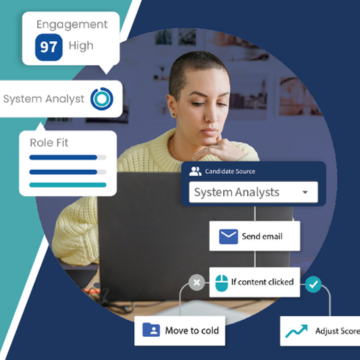- Solutions
- Products
- Community
- Resources
- Company
Create incredible candidate experiences that communicate your brand, mission, and values with recruitment marketing solutions.
Learn moreCommunicate effectively and efficiently with the candidates that can drive your business forward.
Learn moreSelect the right candidates to drive your business forward and simplify how you build winning, diverse teams.
Learn moreHelp your best internal talent connect to better opportunities and see new potential across your entire organization.
Learn moreCommunicate collectively with large groups of candidates and effectively tackle surges in hiring capacity.
Learn moreAccess tools that help your team create a more inclusive culture and propel your DEI program forward.
Learn moreRebound and respond to the new normal of retail with hiring systems that are agile enough to help you forge ahead.
Learn moreAccelerate the hiring of key talent to deliver point of care and support services that meet and exceed your promise of patient satisfaction.
Learn moreAttract and engage candidates with technical competencies, accelerate hiring for much-needed skills, and advance expertise within your valued workforce.
Learn moreSimplify how you recruit finance, insurance, and banking candidates with a unified platform built to match top talent with hard-to-fill roles.
Learn moreYour business strategy depends on your people strategy. Keep both in lockstep with the iCIMS Talent Cloud.
Learn moreBuild an engaging, high-converting talent pipeline that moves your business forward.
Learn moreDeliver the innovation your talent team needs, along with the global scale and security you demand.
Learn moreDeliver tailored technology experiences that delight users and power your talent transformation with the iCIMS Talent Cloud.
Learn moreThe #1 ATS in market share, our cloud-based recruiting software is built for both commercial and large, global employers.
Learn more Talk to salesAttract the best talent for your business with powerful, on-brand career websites that excite candidates and drive engagement.
Learn more Talk to salesCombine behavior-based marketing automation with AI insights to build talent pipelines, engage candidates with multi-channel marketing campaigns, and automatically surface the right talent for the job.
Learn more Talk to salesEmpower candidates with automated self-service, qualification screening, and interview scheduling through an AI-enabled digital assistant.
Learn more Talk to salesSimplify employee onboarding with automated processes that maximize engagement and accelerate productivity.
Learn more Talk to salesVerify skills with game-changing levels of automation and simplicity to improve the quality of hire at scale.
Learn more Talk to salesModernize, streamline, and accelerate your communication with candidates and employees.
Learn more Talk to salesTransform the talent experience by showcasing your authentic employer brand through employee-generated video testimonials.
Learn more Talk to salesSimplify recruiting, dynamically engage talent, and reduce hiring bias with job matching and recruiting chatbot technology.
Learn moreStreamline and centralize your HR tech stack with configurable, flexible, secure and reliable integrations.
Learn moreHow a beloved restaurant hires 40,000+ annually with a great candidate experience.
Learn moreThousands strong, our global community of talent professionals includes creatives, innovators, visionaries, and experts.
Learn moreTogether we’re creating the world’s largest ecosystem of integrated recruiting technologies.
Learn morePartner with our global professional services team to develop a winning strategy, build your team and manage change.
Learn moreExplore our network of more than 300 certified, trusted third-party service and advisory partners.
Learn moreUncover unique market insights, explore best practices and gain access to talent experts across out library of content.
Get resourcesExpert guidance about recruitment solutions, changes in the industry, and the future of talent.
Learn moreStay up to date with the latest terminology and verbiage in the HR software ecosystem.
Learn moreEmployers everywhere improve hiring efficiently and save money using iCIMS. Estimate the potential business value you can achieve.
Learn moreDive into the Class of 2023 Report highlighting this cohort’s expectations and where employers are willing — and able — to meet them.
Watch nowPartner with iCIMS to build the right strategies, processes, and experience to build a winning workforce.
Learn moreExpert guidance about recruitment solutions, changes in the industry, and the future of talent.
Learn moreDeliver the innovation your talent team needs, along with the global scale and security you demand.
Learn moreView press releases, media coverage, and the latest hiring data. See what analysts are saying about iCIMS.
Learn moreiCIMS is the Talent Cloud company that empowers organizations to attract, engage, hire, and advance the talent that builds a winning workforce.
Learn moreGet to know the award-winning leadership team shaping the future of the recruiting software industry.
Learn moreWe believe the future of work isn't something that "happens" to you. It's something you create. We actively create the future of work with our customers every day.
Learn moreiCIMS is committed to being a responsible and ethical corporate citizen, which is why Environmental, Social and Governance (ESG) initiatives are strategic imperatives.
Learn moreStreamline your tech stack and take advantage of a better user experience and stronger data governance with ADP and the iCIMS Talent Cloud.
Learn moreThe combined power of iCIMS and Infor helps organizations strategically align their business and talent objectives.
Learn moreOur award-winning partnership with Microsoft is grounded in a shared desire to transform the workplace and the hiring team experience.
Learn moreOur partnership with Ultimate Kronos Group (UKG) supports the entire talent lifecycle by bringing frictionless recruiting solutions to UKG Pro Onboarding.
Learn moreLet’s get in touch. Reach out to learn more about iCIMS products and services.
Learn more

The pay transparency movement is building momentum. As Gen Z and Millennials dominate the workforce, they are looking for transparency as candidates and employees. The number of US states enacting and enforcing laws in this area continues to grow. As a TA leader, if you’re not already implementing pay transparency in your talent strategy, you’re not alone – but this is your sign to start thinking about it.
According to a survey by Reed, one of the UK’s largest recruitment companies, only 46% of the 252 hiring managers surveyed said their organization had a salary transparency policy. According to the same survey, 78% of candidates were less likely to apply for a role where the posting didn’t include a salary, and 22% wouldn’t even consider applying for positions that do not share salary information.
In a competitive hiring landscape, every step you take to attract candidates is imperative. But once you get them to your career site, how do you get them to convert to applicants? Transparency across your career site regarding your company culture and compensation drives job seekers who are the right fit for your company to apply. Perhaps more important, the modern job seeker expects recruiters to be able to describe their organization’s pay practices in detail and to understand candidate preferences and expectations.
At iCIMS, we have the largest ecosystem in talent acquisition with over 700 active partners. This means we can offer access to subject matter experts on all aspects of talent strategy, from consultants, advisors, and integrated technology providers to our customer community. Compa is an iCIMS partner that provides offer management software designed to make compensation easy for recruiters to understand and communicate. In this post, the Compa team offers some details on the benefits of pay transparency, where to start, and the compliance standards involved.
Our friends at Compa say that the first step is to build a strong relationship between your recruiters and the compensation team. It’s a win-win relationship that benefits from the other’s insight. The compensation team can better understand where the salary expectations are in the market from recruiters. This can help you know if your organization is competitive enough with salary and benefits to retain your workforce or if there is a chance you are susceptible to losing top talent.
Recruiters, on the other hand, need to manage conversations about pay compliantly and with confidence. Having a solid connection with your compensation team means recruiters can communicate the company’s compensation strategy well, allowing them to gain an advantage in winning over talent.
Pay transparency provides level–setting expectations among recruiters and candidates. Nearly one-third (32%) of HR and recruiting pros say entry-level salary expectations are too high. According to the iCIMS Class of 2022 report, seniors and recent grads expect an average salary of $70,005 for entry-level work. Putting expectations up front allows for less friction in the negotiation stages. We also learned in the Class of Covid report that there is still a staggering disparity in salary expectations between graduating men and women. Female college seniors and recent graduates expect to earn $10,000 less yearly than their male counterparts ($60,658 vs. $70,748). Pay transparency across job postings can help close the pay inequality gap across gender and diversity.
You can learn more about pay transparency in Compa’s on-demand webinar: Rethinking Market Data in the New Era of Pay Transparency.
A growing number of states are enabling the benefits of pay transparency for candidates. New York and Colorado have enacted laws that require organizations to disclose salary ranges for open positions to provide pay transparency to all candidates; other states and countries are looking to enact similar laws/requirements soon. Companies may soon find they will need to disclose this information at scale.
The expanding number of new and increasingly complex laws in the US and other countries makes it harder for organizations to stay compliant, especially when recruiting remote workers across the US. Proposed and recently passed legislation ranges from salary history bans to pay range disclosure requirements. To help navigate local laws, Compa created a pay transparency legislative map specifically for talent acquisition teams to reference rules by geography. Many organizations are adopting a more open standard practice of disclosure that meets requirements across various states to simplify their process.
The shift to remote work has made it more challenging to manage pay practices across geographies, especially for knowledge worker roles in high demand that can command Bay Area or New York wages in traditionally lower cost-of-living locations like Nashville or Salt Lake City. Talent teams should carefully monitor how effective their pay guidelines are by geography – a growing trend in offer declines in a particular metro area could mean pay is falling behind in a fast-changing market. It’s helpful for recruiters to understand the difference between the cost of living and the cost of labor.
You do not have to be in talent acquisition for long to know that this hiring landscape has been relentlessly evolving, on what seems like a daily basis, for the last two years. Pay transparency is here to stay as part of the new normal, and it is time to start planning for it.
Learn how to hire top talent without overpaying. Join Compa’s live webinar.




